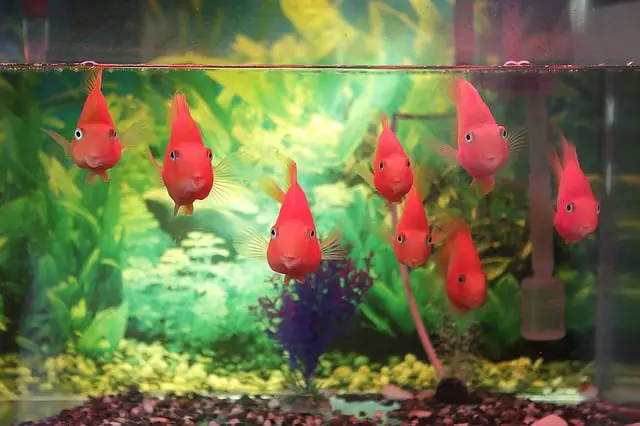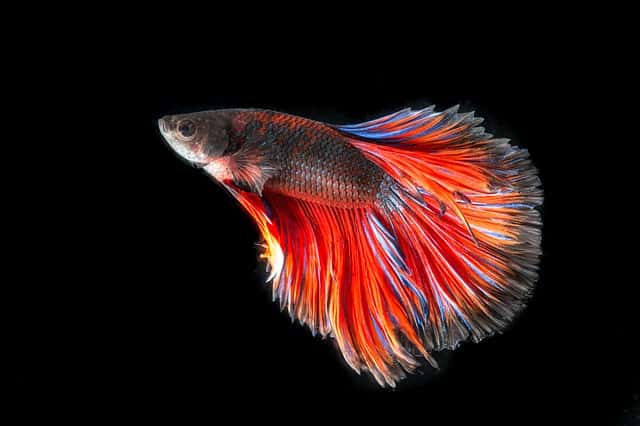When you look at a sponge filter in an aquarium at your favorite local fish store, you might think it is being used because it is cheap. Especially, since the fish are typically in and out of the store so fast. This perception coming from an inexperienced aquarium owner is valid. A fish store is in the business of selling fish not keeping them in the tanks for any extended amount of time. However, this is not the reality with sponge filters.
A sponge filter provides good enough filtration for most aquariums. As with all types of aquarium filters, the correct size of sponge filter should be used for optimal water conditions and beneficial bacteria growth. A sponge filter is a good choice for fish tanks that require less water flow for fish such as bettas or guppies as well as planted tanks. Sponge filters also add oxygen to the tank causing surface agitation for gases to be exchanged.
As we all know, a sponge filter is not the nicest thing to be looking at in an aquarium, however, they do have real value in being part of your fish tank setup. After reading the last paragraph you now know their value.
Speaking of value, a sponge filter with an air pump is much cheaper to purchase than a HOB or Canister filter. That alone should sway some hobbyists to go this route. If not, then keep reading to find out more on why sponge filters are worth having in your tank.
Can You Use Only a Sponge Filter?
In most tanks, yes. Having only sponge filters will work fine in most tanks, for most setups. You may need to have more than one sponge filter if the tank is larger. Anything over 70-gallons warrants the possibility of more than one sponge filter.
Another option for a much larger tank is to have a sponge filter on one end of the aquarium and a powerhead on the other end to ensure all water is flowing throughout the tank.
To find out why only sponge filters are okay in a fish tank, please read on…
How Does a Sponge Filter Work in an Aquarium?
A sponge filter is a simple piece of equipment.
- To put it plainly – you have a plastic body where a sponge sits. Different manufacturers make different styles.
- A rubber tube is connected to the plastic body of the sponge filter (usually in the center) on one end and on the other end it is connected to an air pump outside of the fish tank.
- When the air pump is turned on, it forces air through the tube and down into the sponge filter. As the air comes out and starts heading up to the surface of the tank, the water is then drawn into the sponge part of the filter.
- If you have any other type of filter such as an HOB or canister style, water is drawn in by a motor that pulls the water into the filter and forces it through the media chamber where you will have a sponge. Maybe a sponge filter is not quite as forceful as these other styles of filters, however, the function is basically the same.
Do Sponge Filters Provide Oxygen?
Yes, a sponge filter provides oxygen in a couple of ways. Let’s look at both ways.
- Since sponge filters are powered with air from an air pump, then technically the filter provides oxygen this way. It is the exact same thing if you had an air stone hooked up. Technically, most sponge filters also have an air stone incorporated into the setup. You are pumping air into the water.
- Second is the oxygen exchange that happens at the water’s surface from when the air bubbles pop once they leave the water. This agitation causes gases at the surface to exchange places. Toxic gases from the tank leave and oxygen is drawn into the water. This is one of the most important reasons to have water movement in the tank.
Are Sponge Filters Good for Planted Tanks?
Sponge filtration is excellent for a planted tank. In fact, if you have a heavily planted tank, you probably do not want too strong of a water flow – just enough to move the water around so the plants move slightly is usually enough.
As explained in the previous section, sponge filters help to provide oxygen to tanks as do live plants. Live plants also help to remove unwanted nitrates in the water which can be toxic to your fish at high levels.
Another good point you should be aware of is that a nicely planted tank can be set up to hide the view of an unsightly sponge filter, if you choose to do so. Just something else to consider.
How Long Does It Take for a Sponge Filter to Cycle?
This will depend on whether your tank has gone through the nitrogen cycle yet or not. In other words, how established your tank is already.
- If you are just setting up your fish tank you can expect the sponge filter to take approximately 4 to 8 weeks to cycle properly. Of course, this will also depend on your experience and how you cycle the tank. If you are new to the hobby, and do not have access to beneficial bacteria from another tank, then expect to wait up to 2 months.
- Now if your tank is already cycled and you have a good substrate with bacteria growing in it then it should not take more than two or three weeks before lots of beneficial bacteria also start growing on the sponge.
What Size Sponge Filter Do You Need?
This question is best answered by the manufacturer you purchase one of these filters from.
What I would recommend is buying a filter that is a bit bigger than what you need. For example, if there are two filters and one says it is good for 10-gallon to 30-gallon tanks and another says that is good for 20-gallon to 40-gallon tank (and you have a 20-gallon one) then get the larger one.
Having a bit of a larger sponge means more space for beneficial bacteria to grow as well as more air being pumped into the tank.
How Often Should I Clean My Sponge Filter?
When it comes to cleaning your sponge on the sponge filter think of less is more. Provided the sponge is not clogged up and there is not any (or much) algae growing on it, consider leaving it.
Remember, that the sponge is one of the most vital components of your tank being healthy. I know I am repeating myself however this is so important to understand. Beneficial bacteria grows on the sponge and it is that bacteria that keeps your water healthy so your fish can stay healthy.
Regarding how often you should clean the sponge, I would recommend no more than once every 4 to 8 weeks.
** Make sure to rinse the sponge in aquarium water that you have siphoned out of the tank during a water change. Doing this preserves the beneficial bacteria. Tap water will kill all bacteria in the sponge **
I know you are thinking well that does not seem often enough. It is though, if you are performing weekly water changes syphoning excess foods and waste out of the substrate.
Here is the thing. When you purchase aquarium filter media for HOB, Canister, and other filter types the packaging always says change once a month or more often. Of course, it says that. If they told you what I am telling you, they would not make as much money because they would not be selling as much.
If you are performing regular maintenance on the tank and your fish look healthy and happy just leave things be.
What is the Best Aquarium Sponge Filter?
Honestly, its hard to go wrong with these types of filters.
For a smaller tank (somewhere around 10-gallons), you can get something like this uxcell brand from Amazon.
For a much larger tank in the 50-gallon or larger range, you could go with this Hygger sponge filter and it even comes with ceramic balls which increases space for beneficial bacteria to grow.
Important to know: Some sponge filters do not come with tubing or air stones. In fact, most do not come with the tubing. You will also need an air pump.
I will make this easier for you. Here are the parts you will need to run a sponge filter.
- Sponge filter of course.
- Tubbing to run from the filter to the air pump so make sure you buy a long enough piece.
- You need an air stone to put on the end of the tubing in the sponge filter.
- You need an air pump. This Tetra model is a good unit.
If you do not want the hassle of trying to figure out what to get, here is a sponge filter kit to get you going. I am not familiar with this brand but just wanted to make you aware that there are also kits available.
Conclusion
A sponge filter is good enough in most freshwater fish tank setups. You might need to add a second filter if your tank is quite large or you might need to include a power head for water flow.
Either way these filters are fine for most aquariums. As previously mentioned, when purchasing make sure you get all the pieces needed to make the filter functional.
Good luck with your setup.
Related Aquariums at Home Articles
Preventing Fish from Getting Stuck to Aquarium Filters
Are Saltwater and Freshwater Filters the Same? (Learn What Filter You Should Use)
Do Guppies Need a Filter to Survive?
HOB VS Canister Filter – Which is Best for You?
Where is Beneficial Bacteria in Aquarium?
Are Fish Tank Filters Noisy? (How to Fix)







